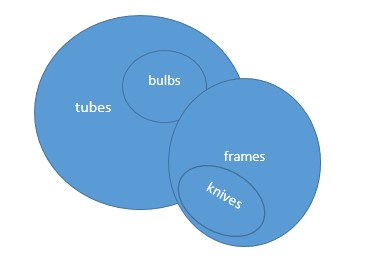Question
Statements- 1.All bulbs are tubes. 2.Some
tubes are knives. 3.All knives are frames. 4.Some frames are bulbs. Conclusions. 1. Atleast some bulbs are frames. 2. Some tubes are not knives. 3. All frames being tubes is a possibility. In each question below there are four statement followed by three conclusion numbered 1, 2 and 3. You have to take the four given statements to be true even if they seem to be at variance with commonly known facts and then decide which of the given conclusions does not follows from the four given statements, disregarding commonly known facts.Solution
Some frames are bulbs(I) ⇒ Conversion ⇒ Some bulbs are frames(I). Hence conclusion I follows. Some tubes are knives(I) ⇒ Conversion ⇒ Some knives are tubes(I). Hence conclusion II does not follow. Some tubes are knives(I) + All knives are frames(A) ⇒ Some tubes are frames(I) ⇒ Conversion ⇒ Some frames are tubes (I) ⇒ Probable conclusion ⇒ All frames being tubes is a possibility(A). Hence conclusion III follows. Alternate Method: 
i) Who is sitting in the second place on the left side of the Dani, Chintu is sitting at the fourth place on the right side.
ii) There are three ...
Which number will replace the question mark (?) in the following series?
6, 20, 42, ?, 110, 156
Select the option that is related to the third word in the same way as the second word is related to the first word. (The words must be considered as me...
Which of the following numbers will replace the question mark (?) in the given series?
−1/729, −1/81, −1/9, ?
If a mirror is placed on the line AB, then which of the answer figures is the right image of the given figure?
In a certain code language, ‘LENGTH’ is written as ‘MDKGSF’ and ESCAPE’ is written as ‘BRDDOZ. How will ‘MARGIN’ be written in that lang...
‘A @ B’ means ‘A is the wife of B’
‘A = B’ means ‘A is the brother of B’
‘A # B’ means ‘A is the son of B’
...
Select the correct mirror image of the given figure when the mirror is placed at MN as shown below.
If a mirror is place on the line XY, then which of the answer figures is the mirror image of the given figure?
Select the figure that will come in place of the question mark (?) in the following figure series.
Relevant for Exams:


